2003 CHEVROLET TRAIL BLAZER wheel torque
[x] Cancel search: wheel torquePage 91 of 436
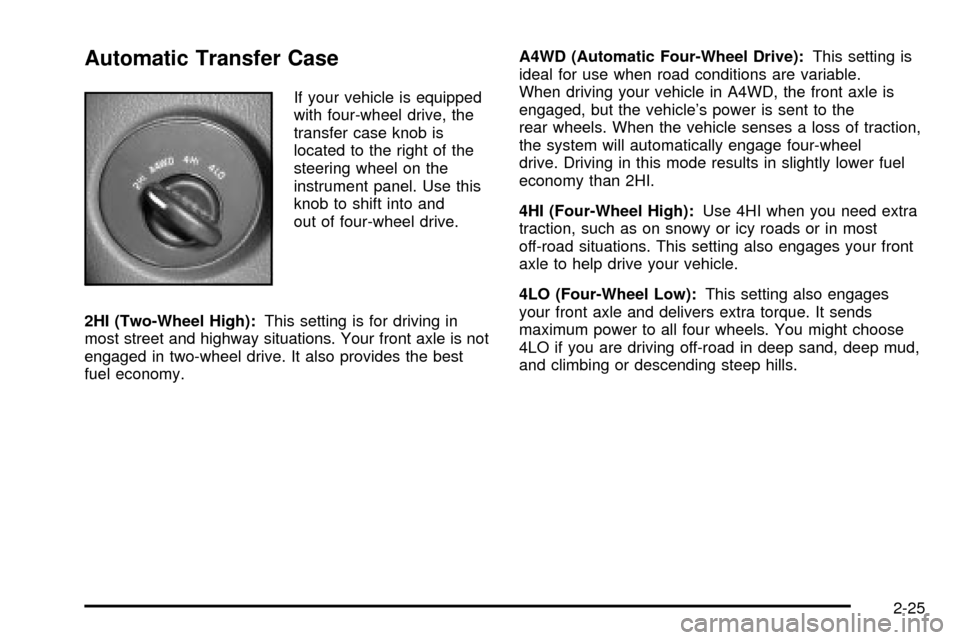
Automatic Transfer Case
If your vehicle is equipped
with four-wheel drive, the
transfer case knob is
located to the right of the
steering wheel on the
instrument panel. Use this
knob to shift into and
out of four-wheel drive.
2HI (Two-Wheel High):This setting is for driving in
most street and highway situations. Your front axle is not
engaged in two-wheel drive. It also provides the best
fuel economy.A4WD (Automatic Four-Wheel Drive):This setting is
ideal for use when road conditions are variable.
When driving your vehicle in A4WD, the front axle is
engaged, but the vehicle's power is sent to the
rear wheels. When the vehicle senses a loss of traction,
the system will automatically engage four-wheel
drive. Driving in this mode results in slightly lower fuel
economy than 2HI.
4HI (Four-Wheel High):Use 4HI when you need extra
traction, such as on snowy or icy roads or in most
off-road situations. This setting also engages your front
axle to help drive your vehicle.
4LO (Four-Wheel Low):This setting also engages
your front axle and delivers extra torque. It sends
maximum power to all four wheels. You might choose
4LO if you are driving off-road in deep sand, deep mud,
and climbing or descending steep hills.
2-25
Page 326 of 436
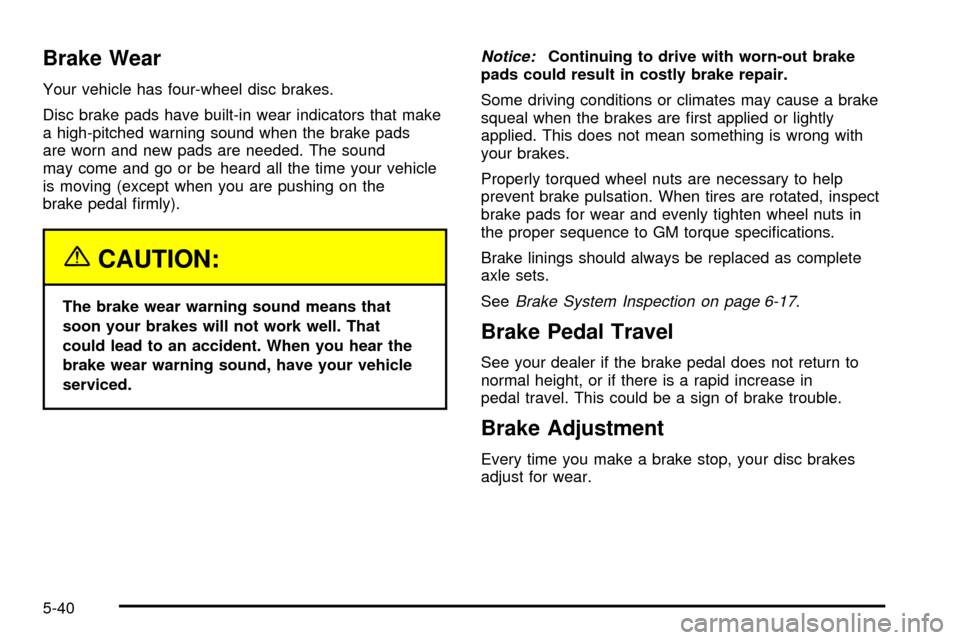
Brake Wear
Your vehicle has four-wheel disc brakes.
Disc brake pads have built-in wear indicators that make
a high-pitched warning sound when the brake pads
are worn and new pads are needed. The sound
may come and go or be heard all the time your vehicle
is moving (except when you are pushing on the
brake pedal ®rmly).
{CAUTION:
The brake wear warning sound means that
soon your brakes will not work well. That
could lead to an accident. When you hear the
brake wear warning sound, have your vehicle
serviced.
Notice:Continuing to drive with worn-out brake
pads could result in costly brake repair.
Some driving conditions or climates may cause a brake
squeal when the brakes are ®rst applied or lightly
applied. This does not mean something is wrong with
your brakes.
Properly torqued wheel nuts are necessary to help
prevent brake pulsation. When tires are rotated, inspect
brake pads for wear and evenly tighten wheel nuts in
the proper sequence to GM torque speci®cations.
Brake linings should always be replaced as complete
axle sets.
See
Brake System Inspection on page 6-17.
Brake Pedal Travel
See your dealer if the brake pedal does not return to
normal height, or if there is a rapid increase in
pedal travel. This could be a sign of brake trouble.
Brake Adjustment
Every time you make a brake stop, your disc brakes
adjust for wear.
5-40
Page 342 of 436
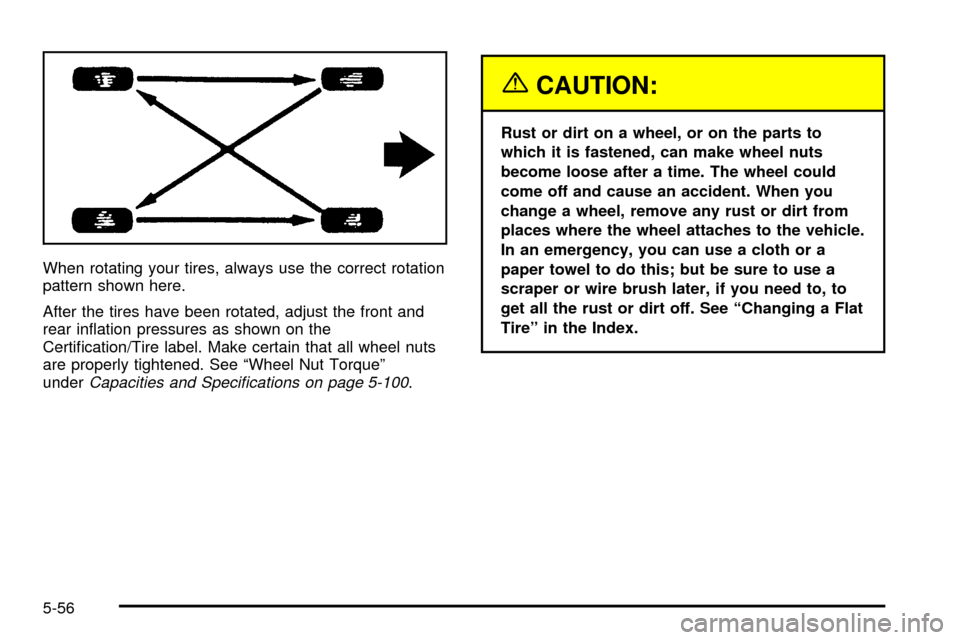
When rotating your tires, always use the correct rotation
pattern shown here.
After the tires have been rotated, adjust the front and
rear in¯ation pressures as shown on the
Certi®cation/Tire label. Make certain that all wheel nuts
are properly tightened. See ªWheel Nut Torqueº
under
Capacities and Speci®cations on page 5-100.
{CAUTION:
Rust or dirt on a wheel, or on the parts to
which it is fastened, can make wheel nuts
become loose after a time. The wheel could
come off and cause an accident. When you
change a wheel, remove any rust or dirt from
places where the wheel attaches to the vehicle.
In an emergency, you can use a cloth or a
paper towel to do this; but be sure to use a
scraper or wire brush later, if you need to, to
get all the rust or dirt off. See ªChanging a Flat
Tireº in the Index.
5-56
Page 361 of 436
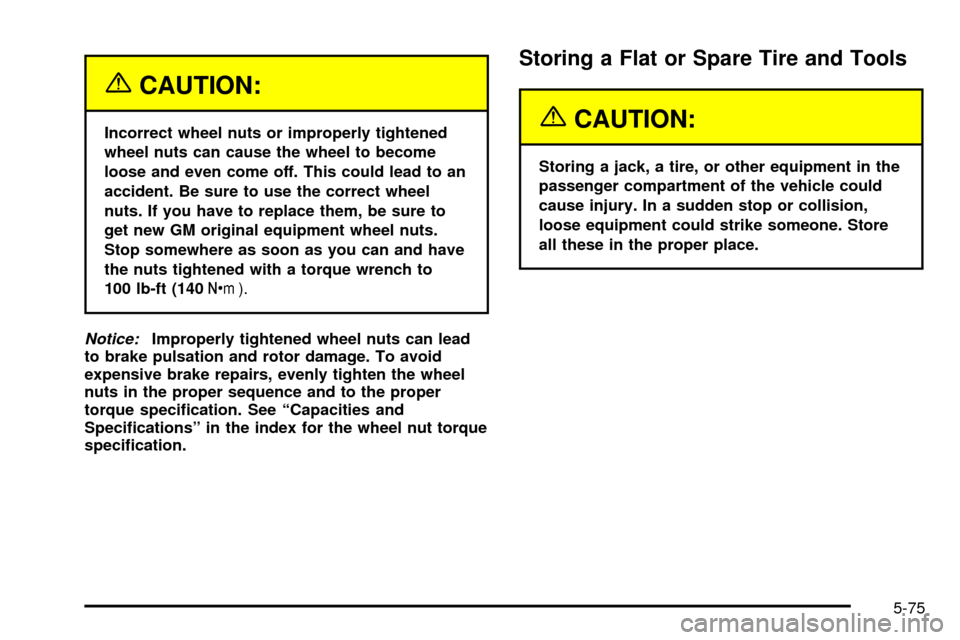
{CAUTION:
Incorrect wheel nuts or improperly tightened
wheel nuts can cause the wheel to become
loose and even come off. This could lead to an
accident. Be sure to use the correct wheel
nuts. If you have to replace them, be sure to
get new GM original equipment wheel nuts.
Stop somewhere as soon as you can and have
the nuts tightened with a torque wrench to
100 lb-ft (140Y).
Notice:Improperly tightened wheel nuts can lead
to brake pulsation and rotor damage. To avoid
expensive brake repairs, evenly tighten the wheel
nuts in the proper sequence and to the proper
torque speci®cation. See ªCapacities and
Speci®cationsº in the index for the wheel nut torque
speci®cation.
Storing a Flat or Spare Tire and Tools
{CAUTION:
Storing a jack, a tire, or other equipment in the
passenger compartment of the vehicle could
cause injury. In a sudden stop or collision,
loose equipment could strike someone. Store
all these in the proper place.
5-75
Page 386 of 436
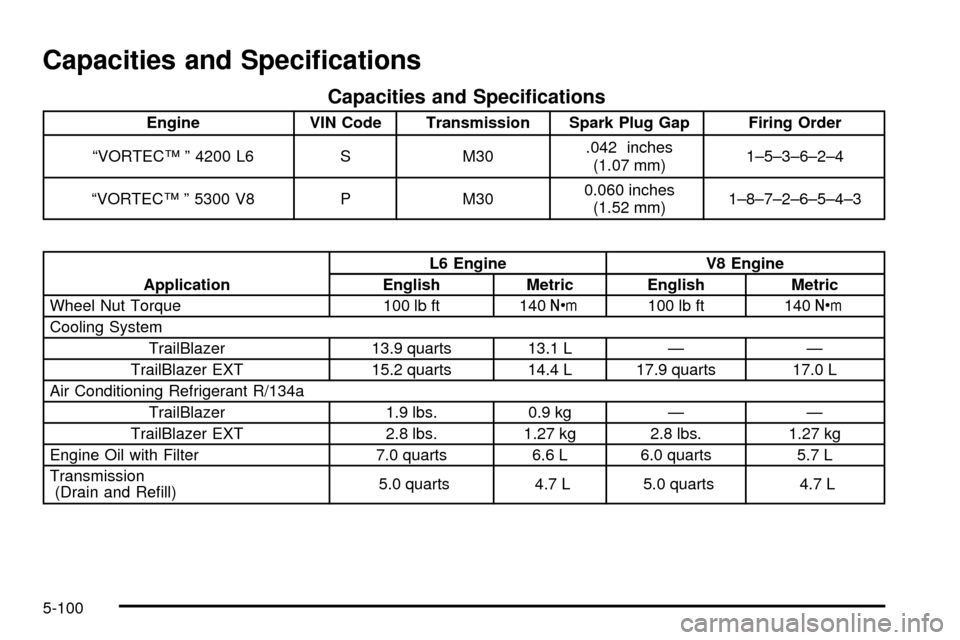
Capacities and Speci®cations
Capacities and Speci®cations
Engine VIN Code Transmission Spark Plug Gap Firing Order
ªVORTECŸ º 4200 L6 S M30.042 inches
(1.07 mm)1±5±3±6±2±4
ªVORTECŸ º 5300 V8 P M300.060 inches
(1.52 mm)1±8±7±2±6±5±4±3
ApplicationL6 Engine V8 Engine
English Metric English Metric
Wheel Nut Torque 100 lb ft 140Y100 lb ft 140Y
Cooling System
TrailBlazer 13.9 quarts 13.1 L Ð Ð
TrailBlazer EXT 15.2 quarts 14.4 L 17.9 quarts 17.0 L
Air Conditioning Refrigerant R/134a
TrailBlazer 1.9 lbs. 0.9 kg Ð Ð
TrailBlazer EXT 2.8 lbs. 1.27 kg 2.8 lbs. 1.27 kg
Engine Oil with Filter 7.0 quarts 6.6 L 6.0 quarts 5.7 L
Transmission
(Drain and Re®ll)5.0 quarts 4.7 L 5.0 quarts 4.7 L
5-100
Page 434 of 436

Steering in Emergencies..................................4-11
Steering, Suspension and Front Drive Axle Boot
and Seal Inspection.....................................6-16
Steering Tips..................................................4-10
Steering Wheel Climate Controls.......................3-34
Steering Wheel Controls, Audio.......................3-106
Steering........................................................4-10
Stereo RCA Jacks..........................................3-94
Storage Areas................................................2-49
Convenience Net.........................................2-49
Front Storage Area......................................2-44
Glove Box..................................................2-43
Luggage Carrier..........................................2-47
Overhead Console.......................................2-43
Rear Floor Storage Lid.................................2-48
Storing a Flat or Spare Tire and Tools...............5-75
Stuck in Sand, Mud, Ice or Snow......................4-42
Sun Visors.....................................................2-15
Sunglasses Storage Compartment.....................2-43
Sunroof.........................................................2-50
T
Table............................................................2-47
Tachometer....................................................3-38
Taillamps.......................................................5-50
Turn Signal Lamps......................................5-50
Testing the Alarm............................................2-17
Theft-Deterrent, Radio....................................3-105Theft-Deterrent Systems...................................2-16
Content Theft-Deterrent................................2-16
Passlock
ž...................................................2-18
Tilt Wheel........................................................ 3-7
Tire In¯ation Check.........................................6-11
Tires.............................................................5-54
Buying New Tires........................................5-58
Chains.......................................................5-62
Changing a Flat Tire....................................5-64
If a Tire Goes Flat.......................................5-63
In¯ation -- Tire Pressure...............................5-54
Inspection and Rotation................................5-55
Uniform Tire Quality Grading.........................5-59
Wheel Alignment and Tire Balance.................5-60
Wheel Replacement.....................................5-61
When It Is Time for New Tires......................5-57
To Use the Engine Coolant Heater....................2-21
Top Strap Anchor Location...............................1-39
Top Strap......................................................1-38
Torque Lock...................................................2-31
Total Weight on Your Vehicle's Tires..................4-54
Towing..........................................................4-44
Recreational Vehicle.....................................4-44
Towing a Trailer..........................................4-50
Your Vehicle...............................................4-44
Traction........................................................... 4-9
Assist System (TAS)...................................... 4-9
Trailer Brakes.................................................4-55
Trailer Wiring Harness.....................................4-60
TRANS HOT IDLE ENGINE.............................3-62
14